In January of 2009, TheParadiddler.com covered Sabian Live at NAMM, via DrumChannel.com (I would have loved to have been there, but since I couldn’t, thanks Drum Channel!). Both the performances and backstage interviews were covered (as best as could be done). One of the artists that dropped by was Walfredo Reyes. No, not Jr. – Sr.
It was very interesting to hear from him and his son Danny what it was like at dinner time at the Reyes household (you can read all about it in the article). It was a very musical environment, the result being a fine ‘batch’ of musicians! Little did I know that covering this event online was a foreshadowing of things to come offline.
Almost a year and a half later (more specifically, May 27th, 2010), Ken Stanton Music in Stone Mountain, GA hosts a drum clinic by none other than Walfredo Reyes, Jr. The family circle is complete! 🙂
The location was familiar enough. TheParadiddler.com also covered Will Calhoun’s clinic there, and it was a sensational experience. It’s not a huge store, which allows for close proximity to the drummer, and a more personal experience.
I was not familiar with Walfredo before the clinic, but I knew he was very well known in the drumming community, having played with many big time artists, such as:
- Santana
- Gloria Estefan
- Toni Braxton
- Lindsey Buckingham
- Christina Aguilera
- Ricky Martin
- Smokey Robinson
- Steve Winwood
…oh my goodness, and on and on and on. That’s just the short list. A session drummer like this must have a wealth of experience to impart, so I knew I it would behoove me to attend. I didn’t go alone this time, however. My partner in crime came with me, my son Devin (the star of the Off-Set pedal review).
We arrived about 40 minutes early or so. I like to take a ‘lay of the land’ so I can know where the good camera shot angles are (plus I like to sit in the front row 🙂 ). I like to mess around with the gear, not just the drums. I didn’t get too much of a chance to set up right away though, because when I walked in, Walfredo was already practicing at the kit!
The gear he was playing on was a beautiful Mapex Meridian Maple kit (I’m going to say the finish was transparent cherry red), with Sabian cymbals and an assortment of ergonomically placed percussion gear (LP bongos, blocks, cowbells, and the like).
Walfredo was practicing with brushes, then with sticks. His playing was very controlled and fast, easily flowing over the whole kit. It’s not that I was surprised, but I was definitely impressed. He made all the fills look incredibly easy.
In addition to practicing by himself, he had a couple of other musicians he was going to play with that evening: Gabriel Monticello on bass, and Myron Feltner on keyboards, two local musicians. The thing to note is that Walfredo had never jammed with these two at all – it would all be spontaneous, improvised.
While the musicians were discussing which direction to take the improvisation, Walfredo demonstrated a few of the more famous drum licks of all time:
- the beginning of “Rock With You”
- thunderous drum fill in “In the Air Tonight”
- Jeff Porcaro on Toto’s “Rosanna”
After practicing, Walfredo got up and greeted some of those already there, myself and my son included. Wally (as he referred to himself) was very friendly and down to earth, very approachable. After the pleasantries Wally went off to prepare for the actual clinic, so that left my son and I to peruse the store.
Sometime after 7pm, Wally re-enters the scene to a most receptive crowd and starts explaining in detail what to expect from the clinic.
He mentioned that he had just recently flown in from Hong Kong, and had just met the two musicians he’d be playing with. He’s very keen on being creative, not being structured when not necessary (although structure is very important too – more on that later). He went on to talk about how music is the ‘universal language’, that even though we may speak different languages, we can all groove to any style of music and ‘get it’, no matter where we’re from. And speaking of where we’re from, he made it a point to stress how grateful we should be in this country that we can so easily go to a local music store and have a wealth of instruments and gadgets to choose from, and people willing to give us lessons. He had been to parts of the world where none of this was available, and anyone interested in percussion would have to fabricate their own sticks. Of course, these sticks would not last for any length of time. Some of those players had such great groove, but could not play for more than a few minutes. So Wally ended up giving out some actual drumsticks so they could at least play for ten minutes straight. Again, we need to appreciate the availability of the instruments here (and the accessibility of music stores, and artists themselves!).
Wally stated that he was going to start playing himself, and then later have the other two musicians join in. He was going to display different styles, from rock, to Latin, Afro-Cuban rhythms – Wally called it the “Wally World Travel Agency”, and boy were we in for a ride!
He started his solo with just his hands and fingers, to something like a world beat, an amazing groove. He then conspicuously incorporated brushes while never losing the beat. He steadily maintained the beat while cleverly alternating between the snare and toms (snares down, by the way).
The Latin beat was ever present, especially when playing the bongos on his left. The ‘woodblock’ and cowbell were prominently played as well. While not skipping a beat, his snares went up and he switched to the regular sticks, and that’s when it got crazy!
Now Wally was playing very fast 32nd’s (who knows, maybe faster 🙂 ). As he varied the tempo, he incorporated the cowbell with a steady beat. It was ever present, even while he was alternating beats between the snare and toms. It was an excellent application of a Latin-type structure in a solo setting.
By this time Wally was on a rampage of dizzying fills, double bass onslaughts, and his arms flailing away all over the place (organized chaos, you could say).
After that fantastic opening, Wally went on to explain some of the origins of the different parts of the kit, particularly the cymbals, which as currently configured on drum kits are really Turkish in origin. The drum kit itself relative to other instruments is a recent development, as in within the last 100 years or so (whereas other instruments have been in existence for centuries, and even drums themselves as individual instruments for as long as humans can remember).
Next was a demonstration of how Wally uses the drum kit to essentially play two parts – the part of the drummer, and of the percussionist. Different parts of the kit could mimic the percussive counterparts, for example:
- hi-hat –> shaker
- snare drum with snares down, and toms –> timbales
- cross-sticking –> woodblock
A drummer in his kit could also incorporate the actual percussive instruments, like the cowbell, woodblock (clave), timbales (or mini-timbales), bongos, etc. Here’s Wally’s kit from behind, where you can pick out the different percussive instruments incorporated into the kit.
With this ‘practical’ percussive kit, Wally demonstrated the samba beat. He made it sound like a percussionist more than a drum kit player, but then that was the point. The drum kit player can be both the percussionist and the kit player (even simultaneously!), while the percussionist is just that. Of course, that’s not a knock on the percussionist, but it’s a specialty. The kit allows for more flexibility. Wally also talked about the ‘bossa nova’ and described it as samba played on a drum kit with jazz.
Wally told a story about when he played with Santana and that for some reason (I don’t remember why) the percussionist was not there. So Wally had to improvise the percussion while still holding down the beat with the kit. Having at least a fundamental knowledge of both the kit and percussion allows for more flexibility (and more gigs!), as has been the case with Wally.
Subsequently, Wally started playing a ‘percussion’ solo, which then slowly morphed into a whole kit solo. It was amazing how the transition was so fluent that you hardly noticed it until he was playing on everything. Great example of using ‘what you got’.
Wally mentioned that he considers himself a ‘rhythmist’. This makes perfect sense because if you look at drumming from a ‘rhythmist’ point of view, your view expands to other percussive instruments beyond the kit. I think that, after seeing this clinic, Wally is the ultimate ‘rhythmist’!
He went on to mention something that I hadn’t thought of before, but it’s very true: ‘Acoustic drums are a reflection of what you put in it.’ You can get a lot of different sounds from an acoustic kit (like getting percussion-like sounds out of the kit, as previously mentioned). Just using the sticks, he struck different spots around the entire kit, and there were so many different sounds generated, very melodic. When you buy an electronic kit, you’re buying specific sounds; you’re playing samples. And even though there have been a lot of developments over the years in percussion and electronics, the mainstay, the acoustic drum kit, has always been the foundation. It’s always there, always needed.
Wally then proceeded to start the next jam with the keyboardist, and then the bass player came in afterwards.
After this jam, Wally demonstrated the dynamic range that the drums have, particularly with brushes. He demonstrated the ‘abanico’, which is the Spanish word for ‘fan’ (as in the device that keeps you cool). It’s like a buzz roll incorporated into a beat.
But one of the coolest things Wally displayed was how to make the drums talk. He made each drum a different member of the family: the kid, the mother, and the father. I call it the ‘Ice Cream Bit’. The kid was asking for ice cream, but the mother had reservations about it. The father emphatically said “no!” The father was the floor tom, while the mother a higher pitched tom, and the kid higher still. It was hilarious. It was very similar to what Marco Minnemann displayed in his drum clinic when he drummed to “What Have the Romans Ever Done for Us?” from the Monty Python movie “Life of Brian”. Both examples displayed how versatile the drum kit is and how it can convey a wealth of moods. Outstanding. This led to another Latin-type jam with the other two players.
Wally then went on to discuss the flexibility that is needed to play to different audiences. You may have great chops, but if your audience is a group of older folks expecting swing, then don’t play rock! Someone once told Wally, “Do not disturb the groove!” If your audience is more a dance-type audience, then play that kind of groove. If your audience is all drummers (say, at a drum clinic), then all bets are off and just go crazy – do it all. That’s what the audience expects!
He then went on to say that it is good to be open to different genres of music because it can have a positive effect on your growth as a musician. He mentioned a funny story about when he was younger and he liked Alice Cooper, but when his father saw “that” he said, “I don’t think so!” Then later Wally’s son is liking Slipknot and Wally said that every song is like Halloween! How the tide turns. But later his son presented him with a very melodic song, and Wally was surprised to find that it was Slipknot! So basically he’s saying that it’s good to have an open mind as far as what effect different genres of music can have on our playing. Of course, he then went into a little reggae jam (sweet!).
There were questions from the audience as well, so one of the questions asked was who were other drummers that influenced him (besides his father, which is an obvious one). It was interesting that he not only mentioned drummers that influenced his drumming (Buddy Rich, Louie Bellson, Ringo Starr, John Bonham), but musical genres, such as salsa. Growing up in Puerto Rico, you can’t help but be surrounded by salsa, and that genre had a big influence in his playing. It shows in how Wally masterfully incorporates percussion into the drum set.
On that note, as far as influences go, Wally said that ‘if you want fresh rhythms, dig deep into the old rhythms’. Many of today’s rhythms are based on different genres of the past, and one would be surprised to find out how diverse and complex some of the older music is, especially in genres like salsa. A plethora of knowledge to say the least.
Wally started drumming at the age of 12, but it was not on a kit. He was ‘forced’ to use just sticks and a practice pad for a full year before he got his kit. This really helped him get the fundamentals down. Nowadays he doesn’t go anywhere without his iPhone and a metronome. You know what they say, ‘timing is everything’! Playing to songs and to a click is essential in learning how to maintain a solid tempo when playing in a band.
Wally told a story about playing with Steve Winwood, and that he was told that a certain song was to be played at 87bpm (I believe the song was “Higher Love”). Sometimes towards the end of a show the band’s adrenaline is pretty high, especially after a receptive crowd. This could be problematic in the sense that the band may tend to speed up the tempo. It’s the drummer’s responsibility ultimately (not exclusively) to maintain that tempo. Even if the band complains later, you can tell them, “You guys said 87bpm, so I stuck to it!”
After the Q&A session, Wally finalized with a freestyle and funk-like jam, and an all out solo to top it all off.
After the drumming and the thunderous applause, Wally stuck around for a long time talking to those in attendance, taking pictures, signing autographs, and answering questions. Very accessible, humble, a class act.
In conclusion, for me it was an unexpected pleasant surprise. In the article “Beyond the Drum Kit”, I mentioned that even though I, like Wally, grew up surrounded by Caribbean music such as merengue, bachata, and salsa, I simply was not interested very much in percussion. My interest was solely on the drum kit side. Wally has completely changed that for me.
I see now that you can have the best of both worlds. You can be a kit player and tastefully incorporate percussion, and still look and sound like a power drummer. There are so many ways to express yourself, so many different tempos, so many different genres, that one is capable of playing if we just open our minds to the possibilities that drum kit percussion provides.
As far as Walfredo Reyes, Jr. goes, he’s made a major impression on me. I was floored by his ‘controlled chaos’, his total control when he played his dizzying array of fills, both hands and feet. He played with such power, but displayed an incredible sense of dynamics and grace, making the drums virtually speak. The fact that he has so masterfully incorporated percussion into the kit solidifies his place, in The Paradiddler’s eyes, as a premier percussionist, a premier rhythmist, of our time. He taught me how to incorporate percussion into the drum kit in a way that’s, well, just dang cool! I think when I grow up (drummingly speaking), I want to be Walfredo Reyes, Jr. 🙂
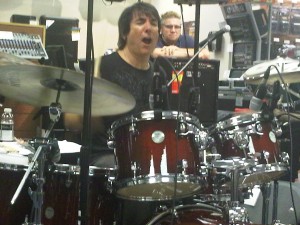
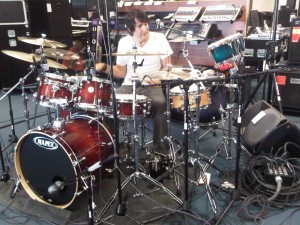
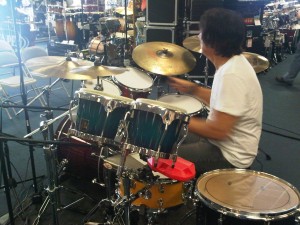
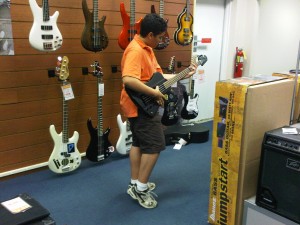
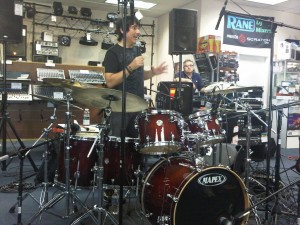
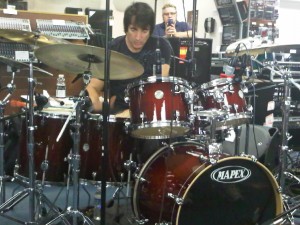
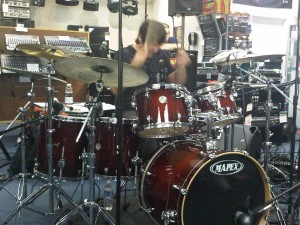

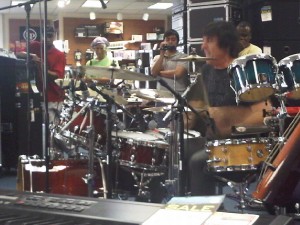
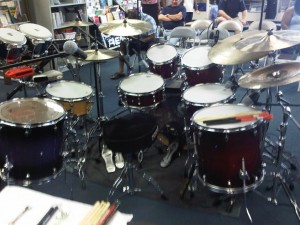
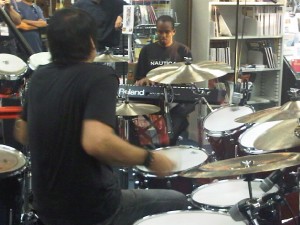
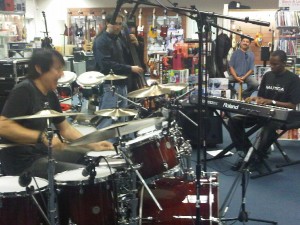
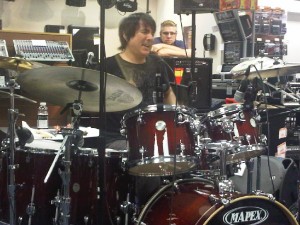
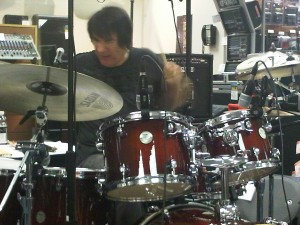
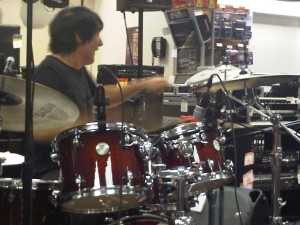
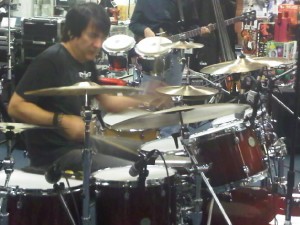

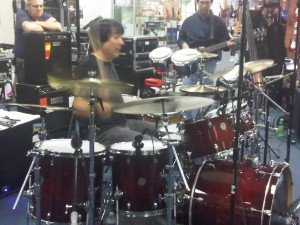
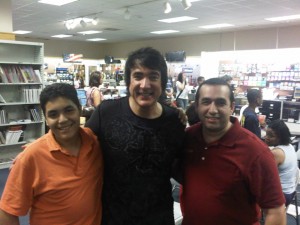

 All rights reserved.
All rights reserved.
{ 2 comments… read them below or add one }
That read was a tour de force Omar. You’re keen eye and ear caught every nuance of touch and nugget of advice. Great work. Peace and drums. Chris
Omar,
Kudos…great article! Keep them coming!
Best wishes,
C.A. (the other Alvarado)